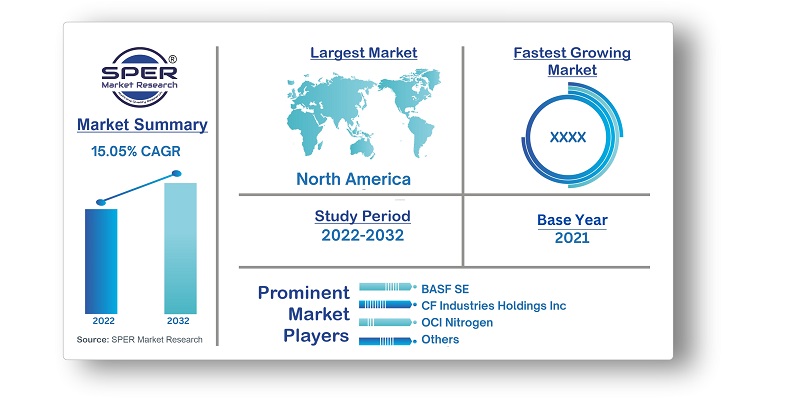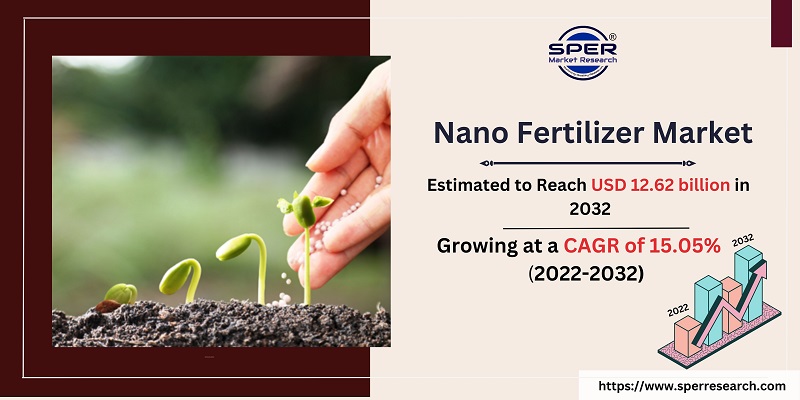
Nano Fertilizer Market Growth, Trends, Share, Size, Revenue, Challenges and Future Scope 2032
Nano Fertilizer Market Size- By Raw Material, By Method of Application, By Application- Regional Outlook, Competitive Strategies and Segment Forecast to 2032
| Published: Mar-2023 | Report ID: AGRI2320 | Pages: 1 - 239 | Formats*: |
| Category : Agriculture | |||
- June 2022: In light of the structural shifts occurring in the global energy, agricultural, and fertilizer industries, Nutrien has declared its plans to increase its fertilizer production capacity.
- In 2022, the CP Group, in collaboration with Charoen Pokphand Foods Public Company Limited, will initiate the CPF Grow-Share-Protect Mangrove Reforestation Project in Trat province, covering an expanse of 1,300 rai. The project aims to enhance biodiversity, preserve the local wildlife and marine ecosystems, drive economic growth in the area, and consequently improve the quality of life for the communities residing near the mangrove forests.

- Opportunities: There is rising demand for nano fertilisers in agriculture: Nanotechnology in agriculture offers eco-friendly and efficient practices. Nano-fertilizers, applied in smaller amounts than traditional ones, can reduce environmental impact by minimizing leaching and emissions.
- Supporting the agricultural sector's needs for sustainable electric power: Nano-fertilizers are expected to aid sustainable agricultural intensification by aligning nutrient release with yield growth, reducing fertilizer inputs, and meeting long-term sustainability goals in farming.
- Challenges: Poor quality of the products: The nano fertilizer market's growth is hampered by subpar product quality, leading to instances where the product provided does not meet expectations and fails to facilitate the nitrogen fixation process, thus impeding market expansion.

| Report Metric | Details |
| Market size available for years | 2019-2032 |
| Base year considered | 2021 |
| Forecast period | 2022-2032 |
| Segments covered | By Raw Material, By Method of Application, By Application |
| Regions covered | Asia-Pacific, Europe, Middle East and Africa, North America, Latin America |
| Companies Covered | BASF SE, CF Industries Holdings Inc., China National Petroleum Corporation, Euro Chem, Fertilizers and Chemical Travancore Ltd., Hindustan Insecticide Limited, Indian Farmer Fertilizer Cooperative Limited, Jiangsu same Group Co, Ltd., Koch Fertilizer LLC, Notore Chemical Industries Plc, Nutrien Ltd., OCI Nitrogen, Petrobras, Qatar Fertiliser Company, SABIC, Yara International ASA, Others |
- Agricultural Companies
- Distributors and Suppliers
- Government bodies such as regulating authorities and policy makers
- Farmers
- Nano fertilizers manufacturers
- Organizations, forums, and alliances related to nano fertilizer
- Others
| By Raw Material: |
|
| By Method of Application: |
|
| By Application: |
|
- Size of Global Nano Fertilizer Market (FY’2019-FY’2032)
- Overview of Global Nano Fertilizer Market
- Segmentation of Global Nano Fertilizer Market By Raw Material (Carbon, Nitrogen, Silver, Zinc, Others)
- Segmentation of Global Nano Fertilizer Market By Method of Application (Spray or Foliar, Soil)
- Segmentation of Global Nano Fertilizer Market By Application (Cereal and Grains, Fruits and Vegetables, Oilseeds and Pulses, Others)
- Statistical Snap of Global Nano Fertilizer Market
- Global Nano Fertilizer Market Growth Analysis
- Problems and Challenges in Global Nano Fertilizer Market
- Global Nano Fertilizer Market Competitive Landscape
- Impact of COVID-19 and Demonetization on Global Nano Fertilizer Market
- Details on Recent Investment in Global Nano Fertilizer Market
- Competitive Analysis of Global Nano Fertilizer Market
- Major Players in the Global Nano Fertilizer Market
- SWOT Analysis of Global Nano Fertilizer Market
- Global Nano Fertilizer Market Future Outlook and Projections (FY’2019-FY’2032)
- Recommendations from Analyst
1.1. Scope of the report1.2. Market segment analysis
2.1 Research data source2.1.1 Secondary data2.1.2 Primary data2.1.3 SPER’s internal database2.1.4 Premium insight from KOL’s2.2 Market size estimation2.2.1 Top-down and Bottom-up approach2.3 Data triangulation
4.1. Driver, Restraint, Opportunity and Challenges analysis4.1.1 Drivers4.1.2 Restraints4.1.3 Opportunities4.1.4 Challenges4.2. COVID-19 Impacts of the Global Nano Fertilizer Market
5.1. SWOT analysis5.1.1 Strengths5.1.2 Weaknesses5.1.3 Opportunities5.1.4 Threats5.2. PESTEL analysis5.2.1 Political landscape5.2.2 Economic landscape5.2.3 Social landscape5.2.4 Technological landscape5.2.5 Environmental landscape5.2.6 Legal landscape5.3. PORTER’S five forces analysis5.3.1 Bargaining power of suppliers5.3.2 Bargaining power of Buyers5.3.3 Threat of Substitute5.3.4 Threat of new entrant5.3.5 Competitive rivalry
5.4. Heat map analysis
6.1 Global Nano Fertilizer Market Manufacturing Base Distribution, Sales Area, Product Type6.2 Mergers & Acquisitions, Partnerships, Product Launch, and Collaboration in Global Nano Fertilizer Market
7.1 Carbon7.2 Nitrogen7.3 Silver7.4 Zinc7.5 Others
8.1 Spray or Foliar8.2 Soil
9.1 Cereals And Grains9.2 Fruits and Vegetables9.3 Oilseeds And Pulses9.4 Others
10.1 Global Nano Fertilizer Market Size and Market Share by Region (2019-2025)10.2 Global Nano Fertilizer Market Size and Market Share by Region (2026-2032)10.3 Asia-Pacific10.3.1 Australia10.3.2 China10.3.3 India10.3.4 Japan10.3.5 South Korea10.3.6 Rest of Asia-Pacific10.4 Europe10.4.1 France10.4.2 Germany10.4.3 Italy10.4.4 Spain10.4.5 United Kingdom10.4.6 Rest of Europe10.5 Middle East and Africa10.5.1 Kingdom of Saudi Arabia10.5.2 United Arab Emirates10.5.3 Rest of Middle East & Africa10.6 North America10.6.1 Canada10.6.2 Mexico10.5.3 United States10.7 Latin America10.7.1 Argentina10.7.2 Brazil10.7.3 Rest of Latin America
11.1 BASF SE11.1.1 Company details11.1.2 Financial outlook11.1.3 Product summary11.1.4 Recent developments11.2 CF Industries Holdings Inc.11.2.1 Company details11.2.2 Financial outlook11.2.3 Product summary11.2.4 Recent developments11.3 China National Petroleum Corporation11.3.1 Company details11.3.2 Financial outlook11.3.3 Product summary11.3.4 Recent developments11.4 Eurochem11.4.1 Company details11.4.2 Financial outlook11.4.3 Product summary11.4.4 Recent developments11.5 Fertilizer and Chemical Travancore Ltd.11.5.1 Company details11.5.2 Financial outlook11.5.3 Product summary11.5.4 Recent developments11.6 Hindustan Insecticide Ltd.11.6.1 Company details11.6.2 Financial outlook11.6.3 Product summary11.6.4 Recent developments11.7 Indian Farmer Fertilizer Cooperative Ltd.11.7.1 Company details11.7.2 Financial outlook11.7.3 Product summary11.7.4 Recent developments11.8 Jiangsu Same Group Co, Ltd.11.8.1 Company details11.8.2 Financial outlook11.8.3 Product summary11.8.4 Recent developments11.9 Koch Fertilizer LLC11.9.1 Company details11.9.2 Financial outlook11.9.3 Product summary11.9.4 Recent developments11.10 Notore Chemical Industries Plc11.10.1 Company details11.10.2 Financial outlook11.10.3 Product summary11.10.4 Recent developments11.11 Nutrien Ltd11.11.1 Company details11.11.2 Financial outlook11.11.3 Product summary11.11.4 Recent developments11.12 OCI Nitrogen11.12.1 Company details11.12.2 Financial outlook11.12.3 Product summary11.12.4 Recent developments11.13 Petrobras11.13.1 Company details11.13.2 Financial outlook11.13.3 Product summary11.13.4 Recent developments11.14 Qatar Fertilizer Company11.14.1 Company details11.14.2 Financial outlook11.14.3 Product summary11.14.4 Recent developments11.15 SABIC11.15.1 Company details11.15.2 Financial outlook11.15.3 Product summary11.15.4 Recent developments11.16 Yara International ASA11.16.1 Company details11.16.2 Financial outlook11.16.3 Product summary11.16.4 Recent developments
SPER Market Research’s methodology uses great emphasis on primary research to ensure that the market intelligence insights are up to date, reliable and accurate. Primary interviews are done with players involved in each phase of a supply chain to analyze the market forecasting. The secondary research method is used to help you fully understand how the future markets and the spending patterns look likes.
The report is based on in-depth qualitative and quantitative analysis of the Product Market. The quantitative analysis involves the application of various projection and sampling techniques. The qualitative analysis involves primary interviews, surveys, and vendor briefings. The data gathered as a result of these processes are validated through experts opinion. Our research methodology entails an ideal mixture of primary and secondary initiatives.



Frequently Asked Questions About This Report
PLACE AN ORDER
Year End Discount
Sample Report
Pre-Purchase Inquiry
NEED CUSTOMIZATION?
Request CustomizationCALL OR EMAIL US
100% Secure Payment






Related Reports
Our Global Clients
Our data-driven insights have influenced the strategy of 200+ reputed companies across the globe.




















